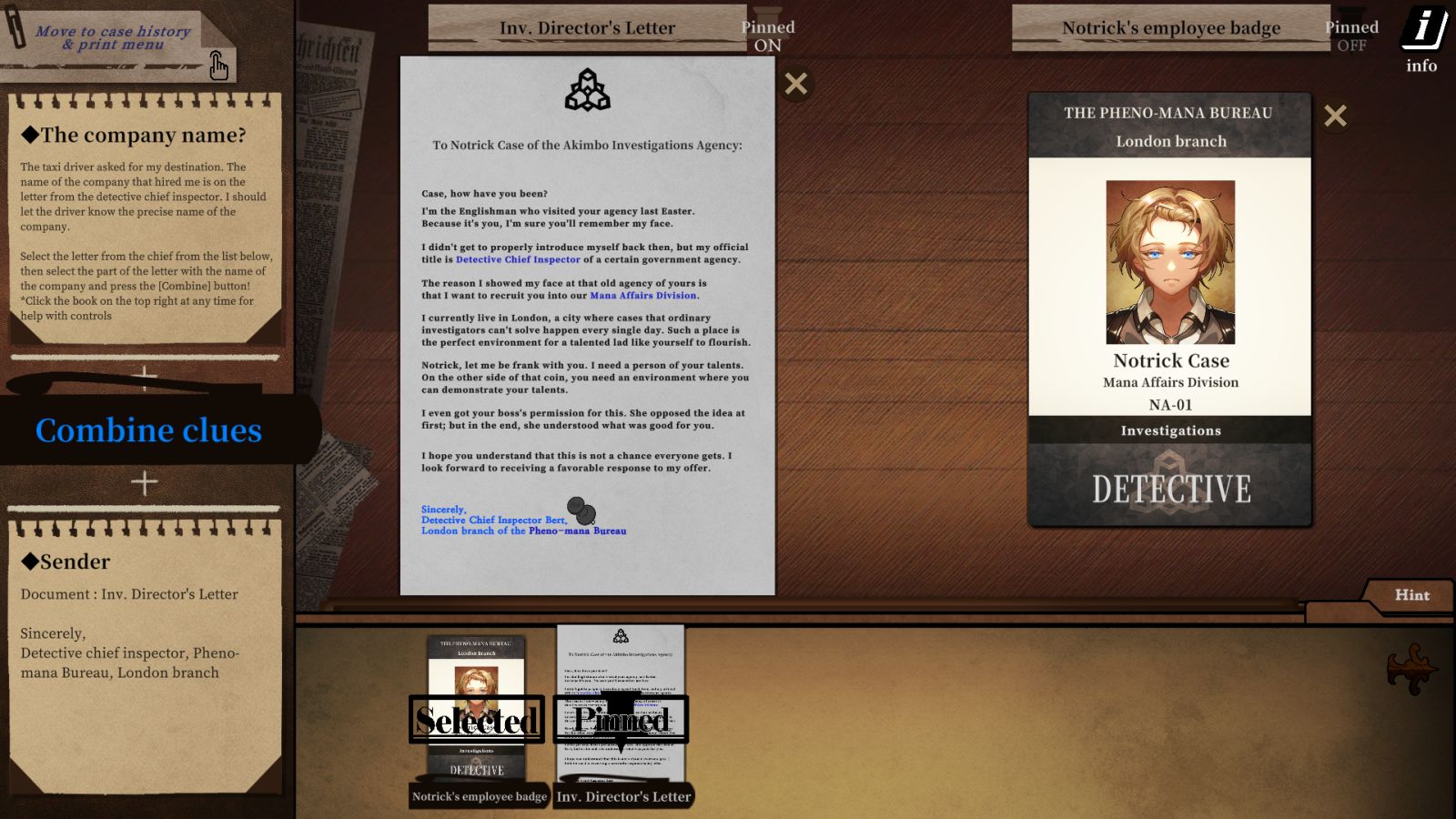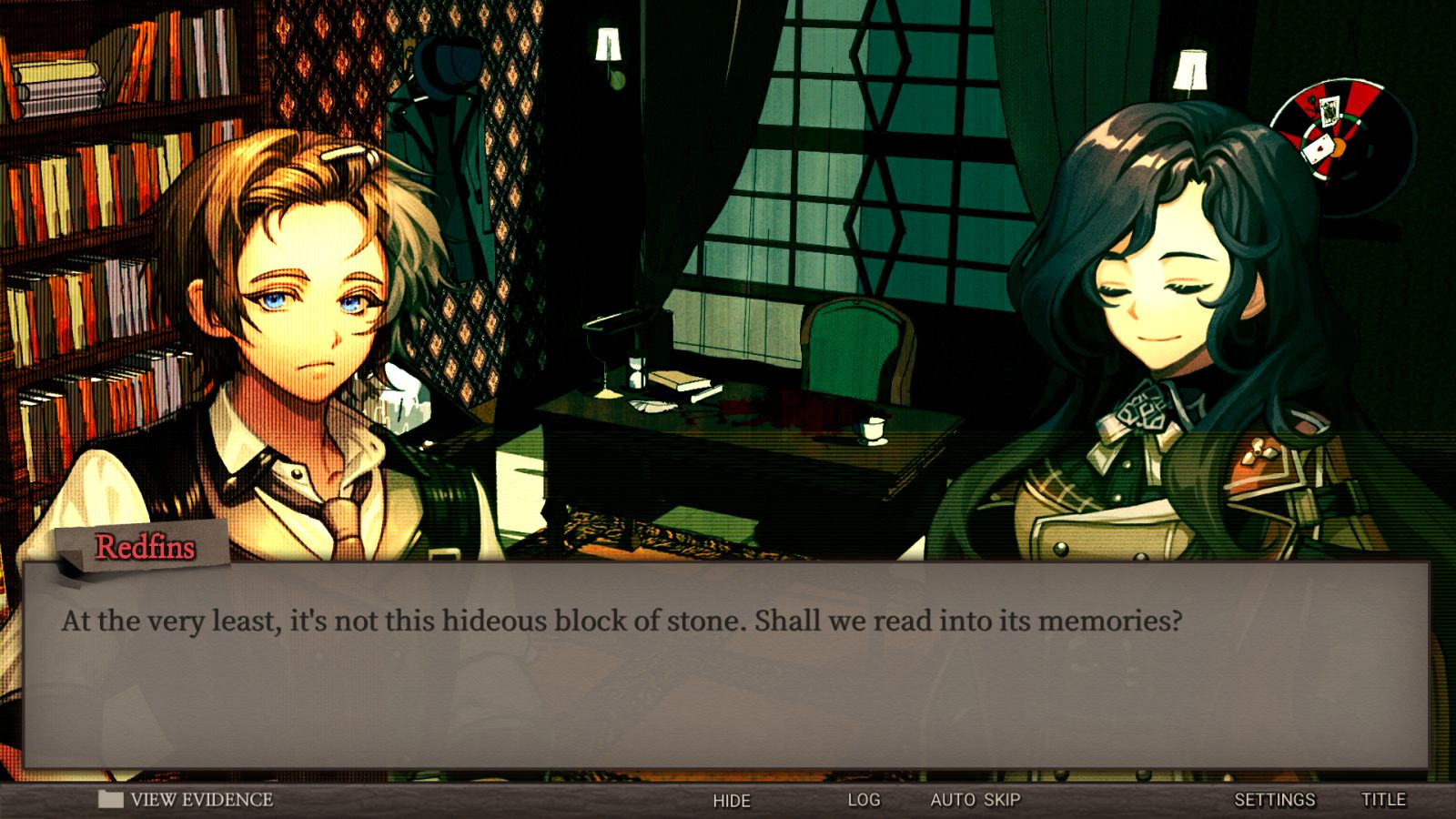Every once in a while, a game is released with such a strong vision that you can tell it has the potential to be a quality series from the first installment. Staffer Case: A Supernatural Mystery Adventure, is one of those games, with a complex narrative, great characters, and an even better setting.
Play as Notrick Case, a sharply dressed young man who wears a fountain pen curled into his bangs. He’s an American traveling to London for the first time to work as an investigator, and the driver of the cab he’s taking to his new workplace is trying to upsell him. He’s noticed that Notrick has paid a hefty sum for the ride, so what’s a little more money for a better drop-off point? Right off the bat, the story tells us that Note is going to be working somewhere important where he’s expected to be paid well, without actually saying it out loud—a good sign for a narrative game.
Notrick succumbs to the cabbie’s nagging but forgets the name of the agency he works for. This brings the player to the investigation portion of the game. Basically, you have to combine the right evidence to get a correct match. All of the important documents and photos are at the bottom of the screen, and the context, case overview, and people of interest are in notes to the left. In this instance, the clues are Notrick’s detective ID and a letter from the chief detective recruiting him to the agency.
The setting is 1960s London, but it’s soon clear that this isn’t the normal timeline. You see, in this world, a mysterious force called Pheno-Mana permeates throughout some people, animals, and objects, granting each unique supernatural abilities. Humans with Pheno-Mana are called “staffers”, objects are called “staff”, and animals are called “creechers”. Naturally, a government agency has arisen to label, track, and occasionally contain those deemed threats to society; The Pheono-Mana Bureau. Their name strikes fear into the hearts of the citizens of London and beyond. They’re exceedingly corrupt, downright authoritarian, and If something shady is going on, you bet they have their hand in it. But in a world where picking the wrong fork out of the drawer can scramble the positioning of your organs, they’re kind of a necessary evil. That goes double when you account for the fact that London has the highest concentration of Staffers, at ten percent of the total population.
There are four levels of danger that the Bureau can assign to someone: Unarmed, meaning harmless; Colt, meaning they have the danger level of a pistol; Estienne, meaning they have the power of a tank; and Oppenheimer, meaning their threat to society is equatable to that of a nuclear bomb. It’s important to point out that danger level doesn’t necessarily equate to destruction output; it’s more so an indicator of how dangerous they are to society. For instance, a staffer whose ability can change a currency into a more valuable variant and manipulate people’s mental state to prevent them from noticing would be rated Oppenheimer. On the other hand, a staffer who can fire medium-power explosives from their fingers would only be considered Estienne.
This brings us back to Notrick, who’s not just joining any old agency, but the experimental investigations division of the Pheno-Mana Bureau. It’s a scrappy, understaffed division with minimal clearance within the agency itself. They barely have access to the staffer files that every staffer must have registered, detailing their abilities and threat level. The first person Note meets right out of the Taxi is Pandoria Redfins, the Sergeant of the division. She’s cool-headed, slightly aloof, yet brash, and doesn’t mind bending the rules a little. Her staffer ability allows her to read the memories of anything she touches, with the exception of people.
Next is Detective Thena. She’s a violent, impulsive, ditzy, hot-headed firecracker of an investigator who whips out her revolver at the drop of a hat. Yet don’t let that fool you into thinking she has no redeeming qualities, she’s the loyal attack dog of the group, and she’s staunchly protective of her friends. She can use vibrations to read people’s heartbeats, thus allowing her to tell if they’re lying or not.
Then we have Detective Bryan. He’s kind and takes any chance he can to help others, even to his detriment. To be honest, he’s quite the pushover, but it’s usually endearing. His ability allows him to see foot and fingerprints, as well as what time they were left.
And of course, there’s the newest member of the division, Detective Notrick, affectionately referred to as “Note” by his fellow investigators. He’s a good guy, and a genius to boot, but he sometimes gets so caught up in the details that he misses the forest for the trees. He’s the only member of the division who isn’t a staffer, but his intellect more than makes up for it.
Now, with the addition of Note, the team has to adjust to the new group dynamic, solve complex cases, and confront past events. There are five cases, each of which takes about two to four hours to complete. The two biggest factors that determine how long a case takes are the speed at which the player solves the puzzles, and which ending they get. You see, cases have two endings, the true ending where the case is solved, and the false ending where at some point, you slipped up. Thankfully, if you get the false ending, the game will give you the option to go back to where the paths diverge. The game did a great job of making sure you’re not retreading too much of the same ground on each path. It really respects the player’s time, and I respect it right back.
During a case, you’ll put each investigator’s skills to use in various logic puzzles. Thena’s speech reviews, Redfin’s memory surveys, and Bryan’s print documents are all on the table. However, it’s not always so straightforward as to look at the document and instantly match the evidence. For example, let’s say Detective Thena has made a document detailing which statements had irregular heartbeats, it’s up to you to determine whether the suspect was lying or just naturally upset at the surrounding events. After all, if somebody’s colleague or loved one was killed mere hours ago, of course he’s going to react to recalling the events. In addition, not everything your fellow detectives say will be completely accurate; sometimes you’ll need to support or oppose one of their statements using a complimentary or contradictory piece of evidence.
The overall nature of solving the smaller parts of the investigation is very forgiving. You can repeatedly get evidence combinations wrong without repercussion. I suspect this wasn’t always the case, as the borders of the screen pulse red after getting a match wrong, or maybe that’s just for effect. Either way, giving the player unlimited tries really gives players room to breathe and deduce the correct answer.
In the same vein, the game’s high demand for specificity wouldn’t really allow for punishing an incorrect answer, as the choices for which evidence will constitute a correct match aren’t flexible enough. Let’s say you’re looking to combine evidence that shows that someone was at the scene of the crime at 8:00 p.m., and there are ten instances proving it across multiple documents. Only a few of those instances will be a correct match. It doesn’t matter if you find their fingerprints on a blood-soaked brick, and Bryan dates them for 8:00 p.m. If the game wants you to select a different answer, you need to do it. This can lead to frustrating moments where the game becomes more trial and error than logical deduction. At the same time, that’s my only big critique of the gameplay, and even then the system isn’t always that picky. Everything else is pretty magnificent.
In Staffer Case, the devil is in the details, and oh boy are there details. The developers at Team Tetrapod went all in on delivering a game that makes you think. The most minor pieces of evidence or scraps of dialogue can have meaning in the overarching investigation. Even the character designs play into the investigation. A seemingly innocuous part of someone’s appearance could very well be a vital piece of information.
Accessing materials like photos and documents is simply convenient. The documents are always available and text logs allow you to go a long way back in conversation. There’s even a hint button that shows you exactly which documents hold relevant information for a match, balancing out the high specificity requirements.
There’s an immaculate series of thrills that arise from combing over the available evidence and developing a hypothesis. Proving your theory wrong or adding to its viability are some of the game’s strongest moments. It really feels like you’re unfurling the truth piece by piece. Cases twist and turn as new evidence always comes to light, so you have to stay sharp, and never get too comfortable with your leading theory.
Getting immersed in the world of Staffer Case is incredibly rewarding. There’s so much lore to dive into and so many complex characters to meet. I especially loved learning my fellow investigator’s backstories to see how they became the people they are. It’s always interesting to see how different people from various walks of life have adapted to the unfortunate world of Pheno-Mana they find themselves in. The societal dynamics between the Bureau and the public they supposedly protect are especially intriguing, as attempts by the Bereau to keep things under control are often counter-effective due to their own infamy. Who would want to go through the Bureau to turn in a dangerous staff item, when they could sell to an illegal dealer for a good price?
The music and art direction really help bring the game to new heights. There aren’t many tracks, but they’re consistently good and are played appropriately. One of my favorites is a spooky electronic mix that gets played during the end of the investigation when you’re putting everything together. When they bust it out, you know the investigation is about to get intense.
On the note of the art, it really sells whatever aesthetic they’re going for at the moment. Whether you’re with the gang in a dingy, run-down building, a sterile top-secret holding facility, or a lush, exorbitant estate, you can rely on the stellar art to establish a clear tone. While there are five investigations with a handful of locations in each one, the visual design ensures that every new location feels fresh and visually distinct.
In the end, Staffer Case: A Supernatural Adventure lays the groundwork for the budding series to become a powerhouse amongst investigative visual novels. If you have any affinity for investigation games with rich lore and endearing characters, then I would highly suggest checking it out. The full game can be found on Steam for $11.99, and you can try the first two cases for free.
























